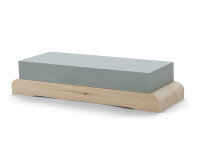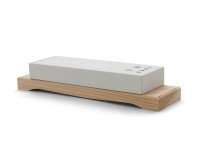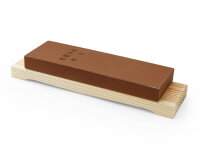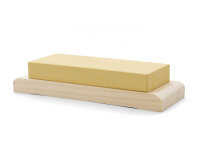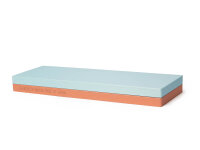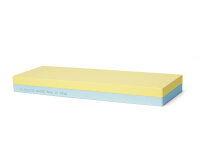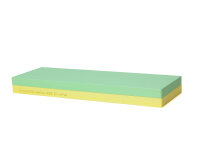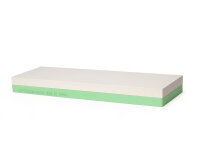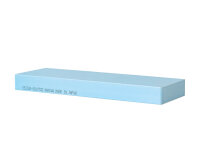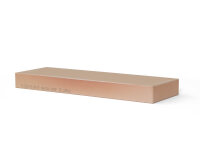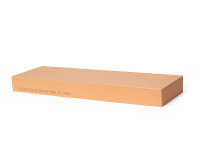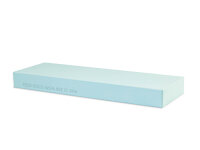
Japanese Sharpening Stones
Sharpening knives on a sharpening stone can be relatively easy to learn
The best knives, including Japanese knives, require some attention from time to time. High-quality Japanese kitchen knives maintain their sharpness for a long time, but even the hardest steel cannot prevent the need for "knife sharpening" at some point. It's a true pleasure when the blades of Japanese kitchen knives are restored to their former sharpness. Owners of Japanese kitchen knives often want to unlock that last bit of sharpness. This can be achieved by following a few rules and dedicating some time to practice.
For quick starters, we have provided a short guide. We describe how to sharpen a knife at the correct angle with ease here.
Sharpening Knives - okay. But how often?
Anyone who has dealt with kitchen knives, their characteristics, their use, and especially the steel they are made of, knows the answer: It depends. Japanese kitchen knives are all made of harder steel than is common in Europe and other Western countries. For hand-forged Japanese high-quality knives, carbon steel, which is particularly hard, is often used, such as Aogami or Shirogami. But even VG-10 steel, often used for the cutting core in Damascus knives, is very hard.
Hardness levels of HRC 59 to 63 and even higher are common. Naturally, both what is being cut and often the surface on which it is being cut affect the edge retention. A partner in Japan who supplies us with high-quality sharpening stones among other things says, "When you can no longer cut tomatoes smoothly and tears flow while cutting onions, those are clear signs that you should sharpen your blade!"
Wet, dry, water, oil, coarse, or fine: Which sharpening stone for knives that are dear to your heart?
Downright deadly for a high-quality dull knife is a grinding wheel, especially a dry one. In general, sharpening without moisture can harm the carbon in the knife due to heat development and the knife will lose its sharpness more quickly. High-quality, hand-forged kitchen knives from Japan are usually made of carbon steel, which has a high carbon content. Dry sharpening works against the advantage of these knives, so sharpening blades like a pro also means understanding a knife. And who understands these blades better than those who have been making them for a very long time: the famous knife smiths in Japan. In response to our inquiry, we received recommendations from several smiths who do not sell sharpening stones themselves: "Use water sharpening stones, preferably from Japan. And if you are not an absolute expert and want a good balance of price and result, use synthetic stones and not natural ones." We were quite surprised because otherwise, our partners always followed the principle that natural comes first.
What are the advantages of using liquid with sharpening stones?
- It forms a sharpening slurry or paste that supports sharpening and improves the edge.
- The abrasion of the sharpening stone and the steel is better carried away.
- If the liquid is thin, the stone is less likely to clog.
- There is a cooling effect that preserves the steel.
- The last point is a matter of feeling, but worth mentioning: We have the impression that you can better feel the effects of sharpening.
Is water for knife sharpening better than oil?
According to our research and inquiries, you can achieve very good results with a high-quality Japanese water stone using both oil and water. The advantages of oil are generally that it lubricates well, the sharpening stone is slightly less worn, and the stone retains the oil, meaning you don't have to replenish the stone with oil as often. If you prefer this approach when sharpening your blades, please ensure that you use a thin oil, as there are special sharpening oils available. We recommend sticking with water for water stones. And that brings us to the disadvantages of oil as a lubricant:
- A sharpening stone cannot be completely de-oiled. So, you're committed to oil once you've used it.
- Oil clogs the sharpening stone faster, especially thick oils.
- Many oils have an unpleasant odor, and some are unhealthy.
- Water is more economical than oil.
- Using oil when sharpening knives leads to more significant contamination.
- The sharpening stone holder tends to slip more with oil.
Which Japanese sharpening stone is the right one?
To get an initial overview, you can categorize sharpening stones into three groups with some overlap based on their grit.
-
Coarse-grit sharpening stone approximately 120 - 800
The rough stones are the brutes among sharpening stones. They are very abrasive, meaning they remove a lot of material. The very coarse grits should be used with caution. The somewhat finer grits are used for the initial grinding of very dull blades. Actual sharpening begins at a grit of 800. -
Sharpening stone grit approximately 800 - 2000
Sharpening stones, as the name suggests, are for actual sharpening. After working with these stones, the blade edge should already feel sharp. -
Sharpening stone grit approximately 2000 - 10000
This group of sharpening stones is for finishing, fine sharpening, and polishing. The range is quite large, and it also depends on how ambitious the knife owner is. However, it is possible to question the need for sharpening stones with a grit above 6000. Above 8000, there is no longer a Japanese knife standard. Based on our experience, a 3000 grit sharpening stone provides very good results, and a 6000-8000 grit sharpening stone achieves nearly perfect blade finishing.
Is a combination stone worthwhile?
For the basic setup, you need at least 2 sharpening stones with different grits. Therefore, combination stones are very popular because the price is usually lower for similar quality compared to two individual stones. If you want to keep your knives sharp and regularly sharpen them, you could choose a combination of a sharpening stone and a finishing whetstone. If someone takes their time, they probably need a lower grit of about 400 and an upper grit of about 1000 and can then decide whether to add a finishing stone for fine sharpening.
Does a Japanese sharpening stone require maintenance?
A tip in advance: After using a Japanese water sharpening stone for your blades, you should wash it, dry it, and let it dry in a well-ventilated place before storing it.
Smoothing the surface:
If you have already used the Japanese sharpening stone, maybe multiple times, you should smooth the surface. Sharpening gradually makes the surface concave, making it difficult to sharpen accurately. This can be done after use with the help of a dressing stone or a piece of sandpaper with a suitable grit on an absolutely flat surface.

